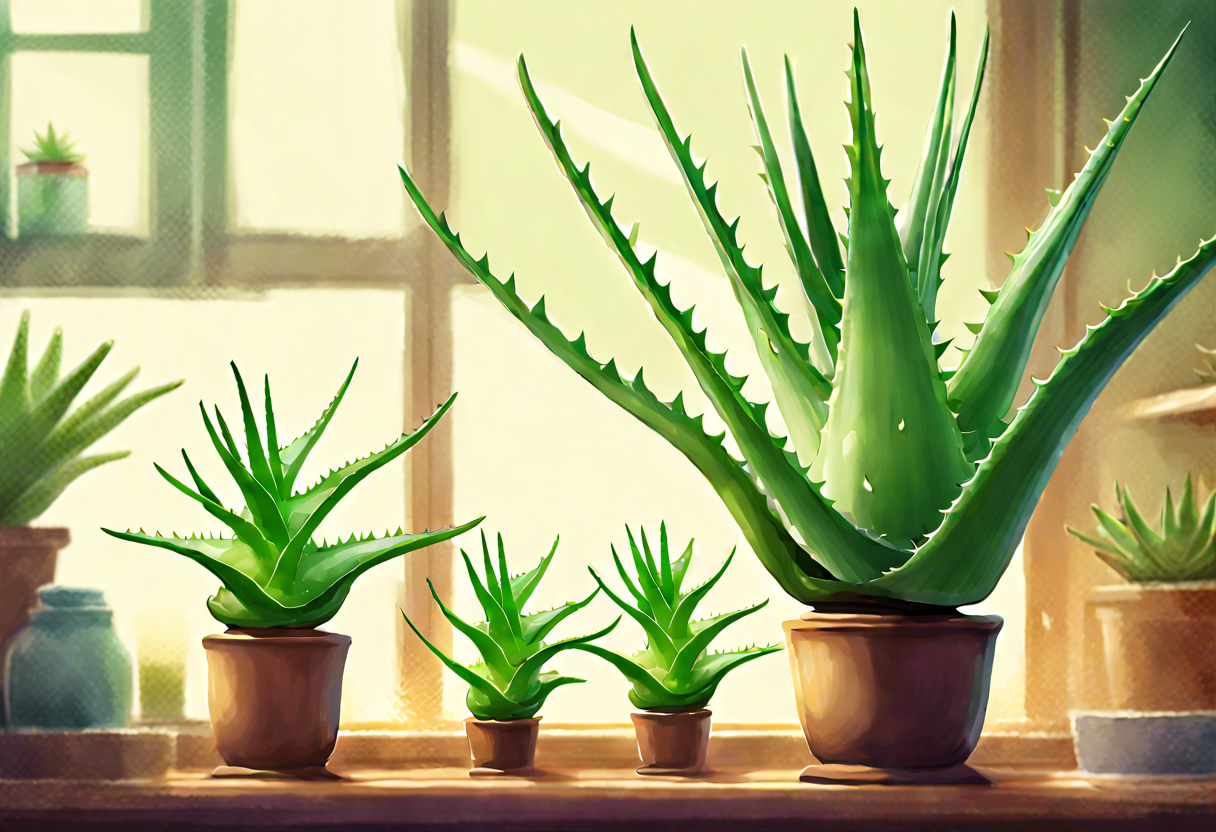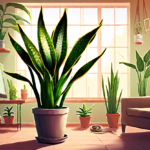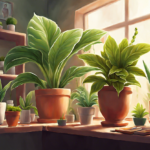Ideal Indoor Conditions for Aloe Plant Growth
When it comes to caring for your aloe plant indoors, providing the ideal conditions is crucial for its growth and overall health. Aloe plants are native to arid environments, which means they thrive in dry conditions with plenty of sunlight. Here are some important factors to consider when creating the perfect environment for your indoor aloe plant:
1. Sunlight: Aloe plants require bright, indirect sunlight to thrive. Place your aloe plant near a south-facing window where it can receive at least six hours of sunlight per day. If direct sunlight is not available, you can also use artificial grow lights to supplement the light requirements.
2. Temperature: Aloe plants prefer temperatures between 60°F to 80°F (15°C to 27°C) during the day and slightly cooler temperatures at night. Avoid exposing your aloe plant to extreme temperature fluctuations or drafts, as they can cause stress and damage to the plant.
3. Humidity: Aloe plants are adapted to low humidity environments, so they do not require high levels of moisture. In fact, excessive humidity can lead to fungal diseases and root rot. Aim for a humidity level of around 40% to 50% for your indoor aloe plant.
4. Air Circulation: Good air circulation is important for preventing the buildup of excess moisture around the leaves and roots of the aloe plant. Ensure there is proper ventilation in the room where your aloe plant is located. You can also use a small fan to improve air circulation if necessary.
5. Potting and Soil: Use a well-draining potting mix specifically formulated for succulent plants. Aloe plants prefer soil that is slightly acidic with a pH level between 6 and 7. Avoid using heavy potting soils that retain too much moisture, as this can lead to root rot.
6. Watering: Aloe plants have low water requirements and are highly susceptible to overwatering. Allow the soil to dry out completely between waterings and ensure that the pot has drainage holes to prevent water from pooling at the bottom. Water the plant thoroughly and then allow the excess water to drain away.
By creating the ideal indoor conditions for your aloe plant, you can ensure its growth and longevity. Remember to regularly monitor the plant’s water and light requirements, as well as keeping an eye out for any signs of pests or diseases. With proper care, your indoor aloe plant will thrive and bring beauty to your living space.
Watering Techniques for Indoor Aloe Plants
Proper watering is essential for the health and vitality of indoor aloe plants. As desert natives, aloe plants have adapted to store water in their fleshy leaves, making them quite tolerant of drought conditions. However, this does not mean that they can survive without any water at all. To ensure optimal growth and prevent common watering mistakes, here are some essential techniques to keep in mind when watering your indoor aloe plant.
First and foremost, it is crucial to understand that aloe plants prefer a well-draining soil. Before watering, always check if the top inch of the soil is dry. Using your finger or a moisture meter, insert it into the soil to determine the moisture level. If the soil feels dry, it is time to water your aloe plant.
When watering your aloe plant, make sure to saturate the soil thoroughly but avoid overwatering. Aloe plants are susceptible to root rot, so it is crucial to allow excess water to drain properly. An effective technique is to water the plant until you see water coming out of the drainage holes at the bottom of the pot. Allow the excess water to drain completely before placing the pot back into its saucer or decorative container.
A common mistake many plant owners make is keeping the soil constantly moist. This can lead to root rot and other related issues. Aloe plants prefer a drying-out period between watering, simulating their natural habitat. As a general rule of thumb, water your aloe plant every two to three weeks, adjusting the frequency based on factors such as temperature, humidity, and the size of the pot.
In addition to the frequency, the amount of water you provide is equally important. Always aim to provide enough water to ensure even moisture distribution throughout the potting soil. Ensure the water penetrates the root zone adequately. To achieve this, water slowly and evenly, allowing the soil to absorb the water thoroughly.
Another crucial aspect of watering aloe plants is the choice of water. Aloe plants thrive best in slightly acidic to neutral pH levels. If you are using tap water, let it sit overnight in an open container to allow any chlorine to dissipate. Alternatively, you can use filtered or rainwater, which are often more suitable for aloe plants and minimize the risk of salt buildup.
By following these watering techniques, you can provide your indoor aloe plant with the right amount of moisture it needs to thrive. Remember, each plant is unique, so always observe your aloe plant for signs of overwatering or underwatering, such as yellowing leaves or wilting. With proper care, your indoor aloe plant will grace your space with its vibrant green leaves and provide you with its incredible healing properties.
Choosing the Right Pot and Soil for Indoor Aloe Plant: Tips and Guidelines
When it comes to caring for your aloe plant indoors, one crucial aspect that shouldn’t be overlooked is choosing the right pot and soil. Providing your aloe plant with the appropriate environment will ensure optimal growth and overall health. Here are some essential tips and guidelines to consider when selecting the perfect pot and soil for your indoor aloe plant.
1. Pot Selection: To accommodate the growth of your aloe plant, choose a pot that has sufficient drainage holes at the bottom. Good drainage is crucial for preventing root rot, which can be fatal to your plant. Additionally, opt for a pot that allows for some extra space as aloe plants tend to produce offsets, also known as "pups," that will require their own room to grow.
2. Size Matters: Aloe plants prefer slightly crowded conditions, so it is best to choose a pot that is just a little larger than the plant’s root system. A pot that is too big can lead to overwatering and potentially harm the plant. A general rule of thumb is to select a container that is 1 to 2 inches wider and deeper than the plant’s root ball.
3. Soil Composition: A well-draining soil mix is essential for aloe plants. Aim for a soil mix that consists of a combination of regular potting soil and perlite or coarse sand. This mixture enhances drainage and prevents waterlogged conditions that can lead to root rot. Avoid using heavy soils like clay-based mixes, which can retain excess moisture.
4. Potting Procedure: Begin by placing a layer of rocks or broken pottery at the bottom of the pot to ensure proper drainage. Fill the pot with the prepared soil mix, leaving enough space to accommodate the aloe plant’s roots. Gently remove the plant from its nursery pot, taking care not to damage the roots. Center the plant in the pot and backfill with soil, ensuring the roots are adequately covered but not excessively buried.
5. Adjusting to the Environment: After repotting, give your aloe plant a few days to adjust to its new home by placing it in a location with indirect sunlight. Avoid exposing the plant to direct sunlight right away, as it can cause sunburn. Gradually increase its exposure to sunlight over time.
By considering these tips and guidelines, you can ensure that your indoor aloe plant thrives in a pot and soil environment that is conducive to its growth and well-being. Remember to provide proper drainage, select an appropriate pot size, use a well-draining soil mix, and allow time for adjustment. With the right pot and soil, your aloe plant will flourish and bring a touch of greenery to your indoor space.
How to Propagate Aloe Plants Indoors
Introduction
Propagating aloe plants indoors is a rewarding and simple way to expand your collection or give new life to an existing plant. Aloe plants can be propagated through various methods, including leaf cuttings and offsets. In this article, we will guide you through the process of propagating aloe plants indoors, step by step.
Step 1: Selecting the Parent Plant
When propagating aloe plants, it is important to choose a healthy and mature parent plant. Look for a plant that is at least three years old and free from pests or diseases. Aloe vera, Aloe arborescens, and Aloe juvenna are common varieties suitable for propagation.
Step 2: Preparing Leaf Cuttings
To propagate aloe plants through leaf cuttings, select a mature leaf from the parent plant. Use a sharp, sterilized knife or shears to make a clean cut close to the stem. Allow the cut end of the leaf to dry and callus for a few days to prevent rotting.
Step 3: Planting Leaf Cuttings
Fill a small pot with well-draining soil mix specifically formulated for cacti and succulents. Make a small hole in the soil and gently insert the cut end of the aloe leaf, ensuring it is planted upright. Place the pot in a warm and bright location, away from direct sunlight.
Step 4: Caring for Leaf Cuttings
Water the leaf cuttings sparingly, allowing the soil to dry out completely between waterings. Overwatering can cause the cuttings to rot. Maintain a temperature between 70°F (21°C) and 85°F (29°C) for optimal growth. After a few weeks, you will notice tiny roots emerging from the cut end of the leaf.
Step 5: Propagating from Offsets
Aloe plants often produce offsets, also known as pups, around the base of the parent plant. These can be separated and grown into individual plants. Wait until the offsets have developed their own roots and are at least one-third the size of the parent plant before separation.
Step 6: Separating Offsets
Gently remove the parent plant from its pot, taking care not to damage the roots. Separate the offsets by gently pulling them away from the main plant. If necessary, use a clean, sharp knife to make a clean cut. Allow the cut ends to dry and callus for a day before planting.
Step 7: Planting Offsets
Plant each offset in a separate pot filled with well-draining soil. Position them upright and cover the roots with soil, leaving the top of the offsets exposed. Water the newly planted offsets lightly, and place them in a warm location with indirect sunlight.
Step 8: Care and Maintenance
The key to successful propagation of aloe plants is providing the right care and maintenance. Indoor aloe plants thrive in bright, indirect sunlight. Rotate the pots regularly to ensure even growth. Water the plants sparingly, allowing the soil to dry out completely between waterings. Overwatering is a common cause of root rot in aloe plants.
Propagating aloe plants indoors is a wonderful way to expand your collection and share the beauty of these succulent gems. Whether you choose to propagate through leaf cuttings or offsets, following these steps will help you achieve success. With patience and proper care, you will soon enjoy a flourishing indoor garden filled with beautiful aloe plants. Happy propagation!
Common Pests and Diseases Affecting Indoor Aloe Plants
When caring for an aloe plant indoors, it is important to be aware of the common pests and diseases that can affect its health. While aloe plants are known for their ability to withstand various conditions, they are still susceptible to certain issues. By being proactive and taking necessary precautions, you can keep your indoor aloe plant thriving and free from pests and diseases.
One of the most common pests that can affect indoor aloe plants is the spider mite. These tiny insects can be identified by their webbing and small size. Spider mites feed on the sap of the aloe plant, leading to discolored leaves and weakened growth. To prevent and control spider mites, regularly inspect your plant for any signs of infestation. If an infestation is detected, isolate the affected plant and use an organic insecticidal soap to eliminate the pests.
Another pest that can pose a problem for indoor aloe plants is the mealybug. Mealybugs are small, white, fluffy insects that cluster in the leaf joints and crevices of the plant. They suck sap from the leaves, causing them to wilt and turn yellow. To get rid of mealybugs, you can use a cotton swab dipped in rubbing alcohol or insecticidal soap to manually remove them from the plant. Regularly monitoring your aloe plant and keeping it clean can help prevent mealybug infestations.
In addition to pests, indoor aloe plants can also be susceptible to certain diseases. One common disease is root rot, which occurs when the plant’s roots are exposed to excess moisture. To avoid root rot, make sure the soil drains well and never let the plant sit in standing water. Overwatering is the leading cause of root rot, so it is important to water your aloe plant sparingly and only when the soil has dried out completely.
Leaf spot is another disease that can affect indoor aloe plants. This fungal infection causes dark spots to form on the plant’s leaves, eventually leading to leaf wilting and death. To prevent leaf spot, avoid overwatering and make sure the plant has good air circulation. If leaf spot occurs, remove the affected leaves and treat the plant with a fungicide.
By being vigilant and taking appropriate measures, you can protect your indoor aloe plant from common pests and diseases. Regularly inspecting the plant, providing optimal growing conditions, and addressing any problems promptly will help your aloe plant stay healthy and vibrant. Remember to always use organic pest control methods and follow the recommended instructions when treating your aloe plant. With the right care, your indoor aloe plant will thrive and bring beauty to your home.
Conclusion
In order to ensure the health and vitality of your indoor aloe plant, it is crucial to provide the ideal growing conditions. Aloe plants thrive when they receive bright, indirect sunlight, so placing them near a south or west-facing window is ideal. If direct sunlight is not available, you can use fluorescent grow lights to supplement the light requirements. Remember to rotate the plant regularly to ensure even growth and prevent leaning towards the light source.
When it comes to watering your indoor aloe plant, it’s important to strike the right balance. These succulents are adapted to survive in arid conditions, so overwatering can be detrimental to their health. Instead, allow the soil to dry out completely between each watering session. When you do water, make sure to thoroughly soak the soil and allow any excess water to drain away. During the winter months or when the plant is in a dormant phase, reduce watering frequency to prevent root rot.
Choosing the right pot and soil is essential for the indoor cultivation of aloe plants. Opt for a pot with drainage holes to prevent water from sitting in the bottom and causing root rot. Additionally, a well-draining soil mix specifically designed for succulents is crucial. You can blend a commercial cactus mix with perlite or pumice to ensure good drainage and aeration for the roots.
Propagation is an exciting way to expand your aloe plant collection indoors. The most common method is through offshoots or "pups" that grow from the base of the mother plant. Gently remove these pups using a clean, sharp knife, and allow the cut ends to dry out for a day or two before planting them in a separate pot with well-draining soil. Alternatively, you can propagate aloe plants from leaf cuttings. Simply cut a healthy leaf from the parent plant, let it dry out for a few days to form a callus, and then place it in a pot with moist soil.
While aloe plants are generally hardy and resilient, they can still be susceptible to certain pests and diseases. Common pests include mealybugs, aphids, and spider mites. Regularly inspect your plants for any signs of infestation, such as sticky residue, distorted leaves, or webbing. If you spot any pests, treat the affected plant with a mild insecticidal soap or a neem oil solution. Additionally, aloe plants can suffer from root rot if overwatered or exposed to excessively damp conditions. To prevent this, ensure proper drainage and avoid standing water around the roots.
Caring for an aloe plant indoors involves providing the right growing conditions, watering appropriately, selecting the correct pot and soil, propagating when desired, and addressing any pests or diseases that may arise. By following these guidelines, you can enjoy the beauty and benefits of this versatile plant within the comfort of your home.


